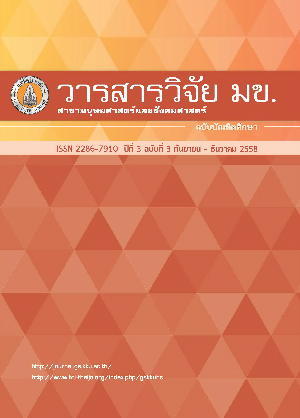การวิเคราะห์ข้อบกพร่องและมโนมติที่คลาดเคลื่อนทางคณิตศาสตร์ เรื่อง การหารเศษส่วน ของนักเรียนชั้นประถมศึกษาปีที่ 6 (Analysis of Prathomsuksa 6 Students’ Mathematics Errors and Misconceptions on Division of Fraction)
Keywords:
ข้อบกพร่องและมโนมติที่คลาดเคลื่อนทางคณิตศาสตร์ (Students’ mathematics errors and misconceptions), การหารเศษส่วน (Division of fraction)Abstract
บทคัดย่อ
การวิจัยในครั้งนี้มีวัตถุประสงค์เพื่อวิเคราะห์ข้อบกพร่องและมโนมติที่คลาดเคลื่อนทางคณิตศาสตร์ เรื่อง การหารเศษส่วน ของนักเรียนชั้นประถมศึกษาปีที่ 6 โดยมีรูปแบบการวิจัยเป็นแบบผสม กลุ่มตัวอย่างในการวิจัยครั้งนี้ คือ นักเรียนชั้นประถมศึกษาปีที่ 6 ในภาคเรียนที่ 2 ปีการศึกษา 2557 โรงเรียนเทศบาลบ้านโนนทัน สำนักการศึกษาเทศบาลนครขอนแก่น จังหวัดขอนแก่น จำนวนนักเรียน 45 คน เครื่องมือที่ใช้ในการวิจัยครั้งนี้ ได้แก่ แบบทดสอบวิชาคณิตศาสตร์ เรื่อง การหารเศษส่วน ชั้นประถมศึกษาปีที่ 6 เป็นแบบอัตนัย จำนวน 8 ข้อ การสัมภาษณ์แบบมีโครงสร้าง ซึ่งวิเคราะห์ข้อมูลด้วยการวิเคราะห์เนื้อหา อัตราร้อยละหรือเปอร์เซนต์ (Percentage or Percent) และนำเสนอด้วยวิธีพรรณนาวิเคราะห์ ผลการวิจัยพบว่า ข้อบกพร่องจากการทำแบบดสอบแบบอัตนัย เรื่อง การหารเศษส่วน ของนักเรียนชั้นประถมศึกษาปีที่ 6 ซึ่งผู้วิจัยได้เรียงลำดับข้อบกพร่องที่พบจากการทำแบบทดสอบเรียงจากมากไปหาน้อย ดังนี้ 1) ขาดการตรวจสอบในระหว่างการแก้ปัญหา 2) การบิดเบือนทฤษฎีบท กฎ สูตร บทนิยาม และสมบัติ 3) การใช้ข้อมูลผิด 4) ข้อบกพร่องในเทคนิคการทำ และ 5) การตีความด้านภาษา มโนมติที่พบจากการทำแบบทดสอบเรียงจากมากไปหาน้อย ดังนี้ 1) มโนมติที่คลาดเคลื่อนทางคณิตศาสตร์ 2) มโนมติทางคณิตศาสตร์แบบไม่สมบูรณ์ 3) ไม่เข้าใจมโนมติทางคณิตศาสตร์ และ 4) เข้าใจมโนมติทางคณิตศาสตร์
ABSTRACT
This research aims to analyze Prathomsuksa 6 students’ mathematics errors and misconceptions on division of fraction. Mixed method was applied in this study.The target group was consisted of 45 Prathomsuksa 6 students who were studying in the 2nd semester of the year 2014, Bannontan Municipal School under the jurisdiction of the Municipality Educational Service, KhonKaen Province. The instruments were 8-item subjective test of mathematics on division of fraction, a structured-interview form. The collected data were analyzed by percentage and the findings were descriptively presented. The findings were: Some students errors and misconceptions on division of fraction were found and categorized ranking from highest to lowest percentage as follow; 1) unverified solutions, 2) distorted theorem or definition, 3) misused data, 4) technical errors, and 5) misinterpreted language. The level of conceptions on division of fraction were; 1) specific misconceptions, 2) partial understanding, 3) no understanding, and 4) sound understanding




